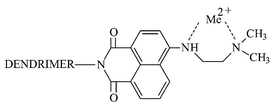A polyamidoamine dendrimer with peripheral 1,8-naphthalimide groups capable of acting as a PET fluorescent sensor for metal cations
Abstract
The effect of some metal ions (Fe2+, Ni2+, Zn2+, Pb2+) upon the fluorescent intensity of a first generation polyamidoamine dendrimer with a peripheral 4-dimethylaminoethylamine-1,8-naphthalimide group was investigated. The presence of metal ions was found to evoke a photoinduced electron transfer leading to an enhancement in the fluorescence. The results obtained reveal the capacities of these systems to act as sensitive detectors of environment pollution by metal ions. The metal ions inhibit the photodegradation of the dendrimer molecule which exhibits PET properties.


 Please wait while we load your content...
Please wait while we load your content...